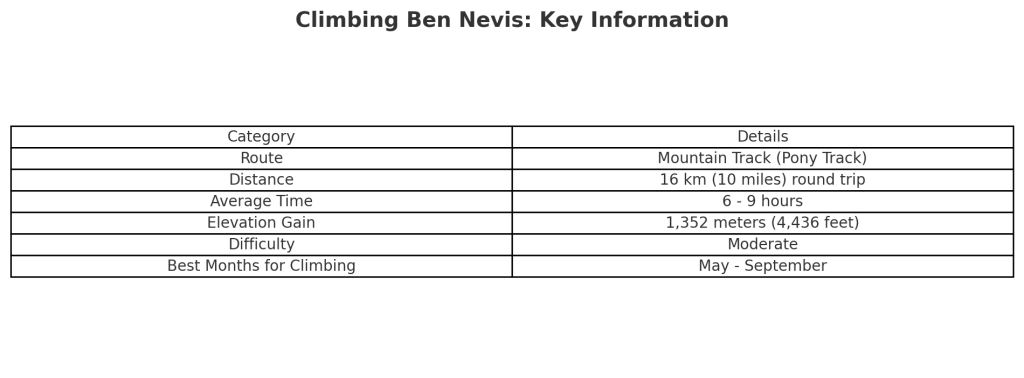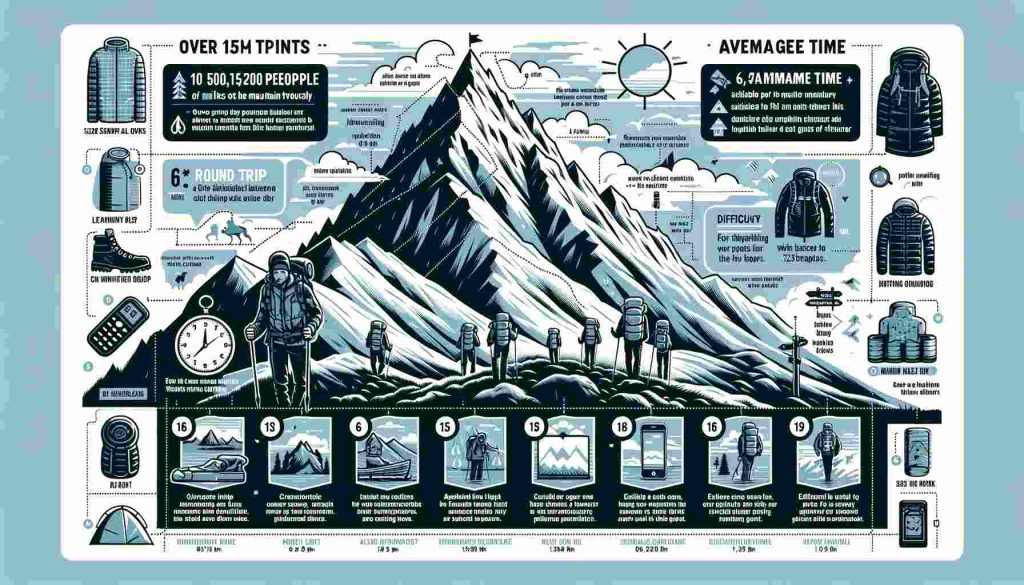Climbing Ben Nevis, the tallest mountain in the British Isles, is an adventure many aspire to undertake. The time it takes to reach the summit varies greatly, typically depending on factors such as the climber’s fitness level, weather conditions, and the specific route chosen.
For most hikers, the journey to the top and back can be completed within 6 to 9 hours, especially when following the popular Mountain Track, also known as the Pony Track. This track, spanning about 16 km (10 miles) round trip, offers a challenging yet achievable climb for those with a reasonable level of fitness.
Let’s dive into the details of climbing Ben Nevis, addressing the most common questions and providing valuable insights to help you plan your journey.
Understanding Ben Nevis
Before we dive into the details of how long it takes to climb Ben Nevis, let’s get to know the mountain a bit better.
1. Location and Elevation
Ben Nevis, often referred to as the “Ben,” is situated in the Grampian Mountains in the Lochaber area of the Scottish Highlands. It stands at an impressive height of 1,345 meters (4,413 feet) above sea level, making it the highest mountain in the British Isles. The peak is known for its unpredictable weather and challenging terrain, which adds to its allure for outdoor enthusiasts.
2. Historical Significance
Aside from its natural beauty, Ben Nevis also holds historical importance. The mountain was named after the Gaelic name “Beinn Nibheis” and has been a popular destination for climbers and hikers for over a century. The path to the summit, known as the Pony Track or the Mountain Track, was constructed in the 19th century, primarily for scientific research and access to the summit observatory.
Now, let’s delve into the time it typically takes to climb Ben Nevis.
Average Time to Climb Ben Nevis
The time it takes to climb Ben Nevis can vary significantly depending on several factors, including your fitness level, the weather, and the chosen route. However, a rough estimate for the average hiker to complete the ascent and descent is around 6 to 9 hours. Here’s a breakdown of what you can expect:
1. Ascent Time
On average, ascending Ben Nevis takes approximately 4 to 5 hours. This time frame is for the Mountain Track, which is the most popular route. The path is well-maintained and relatively easy to follow. It starts near the Glen Nevis Visitor Center and leads you gradually up the mountain.
2. Summit Stay
Once you reach the summit, you might want to spend some time taking in the breathtaking panoramic views of the Scottish Highlands. Depending on your personal preferences and the weather conditions, your summit stay can vary from 15 minutes to an hour or more.
3. Descent Time
The descent from the summit back to the starting point generally takes around 2 to 3 hours. The descent can be quicker than the ascent, but it can also be physically demanding, especially on the knees and joints. Be cautious when descending to avoid accidents.
Keep in mind that these times are just averages and can vary widely based on your fitness, weather conditions, and any stops you make along the way. It’s always a good idea to plan for extra time in case of unforeseen delays.
Factors That Affect Climb Time
Now that you have a rough estimate of the average time, let’s explore the factors that can influence how long it takes to climb Ben Nevis.
1. Fitness Level
Your fitness level plays a significant role in determining your climb time. If you’re an experienced hiker in good shape, you may complete the hike more quickly than someone who is less fit. However, regardless of your fitness level, it’s essential to pace yourself and take breaks to avoid exhaustion.
2. Weather Conditions
The weather on Ben Nevis can change rapidly, even during the summer months. Fog, rain, snow, and strong winds are common, so be prepared for adverse conditions. Poor weather can slow your progress and make the climb more challenging. Always check the weather forecast before heading out and come equipped with appropriate clothing and gear.
3. Group Size
The size of your group can also affect your climb time. Larger groups may move more slowly due to coordination and varying fitness levels. Conversely, smaller groups or solo hikers may have more flexibility in their pace.
4. Trail Conditions
While the Mountain Track is well-maintained, trail conditions can vary, especially in winter or after heavy rainfall. Slippery rocks and muddy paths can slow your progress, so make sure you have appropriate footwear and trekking poles if needed.
5. Rest Stops and Photography
Many hikers like to take breaks to rest, enjoy the scenery, and capture photos. These stops can add extra time to your climb, but they are essential for safety and enjoyment. Be mindful of your surroundings and take the time to appreciate the natural beauty of Ben Nevis.
Preparing for Your Ben Nevis Climb
Now that you have a good idea of the average climb time and the factors that can affect it, let’s discuss how to prepare for your Ben Nevis adventure.
1. Check the Weather
As mentioned earlier, checking the weather forecast is crucial. Websites, apps, or local visitor centers can provide up-to-date information on current conditions and forecasts. Be prepared for sudden changes and pack accordingly with waterproof and windproof clothing.
2. Proper Gear
Having the right gear can make your climb much more comfortable and safe. Here’s a list of essential gear:
- Sturdy hiking boots with ankle support
- Waterproof and windproof clothing (including jacket and pants)
- Warm layers (such as fleece or down)
- Hat and gloves
- Sun protection (sunscreen, sunglasses, and a hat)
- Map and compass or GPS device
- Headlamp or flashlight with spare batteries
- Food and water (carry more than you think you’ll need)
- First aid kit
- Backpack to carry your gear
- Trekking poles (optional but can be helpful, especially during the descent)
3. Physical Preparation
While Ben Nevis is accessible to most hikers, it’s still a challenging climb. To prepare physically, consider the following:
- Cardiovascular fitness: Regular aerobic exercise like hiking, running, or cycling can improve your stamina.
- Leg strength: Strength training exercises that target your legs will help with the ascent and descent.
- Endurance: Gradually increase the duration of your hikes to build endurance for longer treks.
4. Safety Considerations
Safety should be a top priority when climbing Ben Nevis. Here are some safety considerations:
- Inform someone of your plans: Let a friend or family member know your itinerary and expected return time.
- Stay on marked trails: Stick to established paths to avoid getting lost.
- Respect the mountain: Leave no trace by taking your trash with you and following the “Leave No Trace” principles.
- Be aware of the time: Start early to ensure you have enough daylight to complete the hike.
- Know your limits: If conditions become too challenging or you feel unwell, it’s okay to turn back.
Alternative Routes
While the Mountain Track is the most popular and well-known route up Ben Nevis, there are alternative routes that offer different experiences and challenges. Here are a few:
1. Carn Mor Dearg Arete
This route starts from the north side of Ben Nevis and involves traversing the spectacular Carn Mor Dearg Arete before reaching the summit. It’s a more challenging and technical route, recommended for experienced hikers and climbers. This route can take longer than the Mountain Track due to its difficulty.
2. CMD Arete and Ledge Route
The CMD Arete route also begins from the north side of the mountain but offers a less technical option than the Carn Mor Dearg Arete. After reaching the summit, you can descend via the Ledge Route for a varied experience.
3. Steall Falls and the Nevis Gorge
For a different perspective of Ben Nevis, consider hiking through the beautiful Nevis Gorge and enjoying the scenery around Steall Falls. While this route doesn’t take you to the summit, it’s a lovely hike that showcases the area’s natural beauty.
Guided Tours and Accommodation
If you’re new to hiking or prefer a guided experience, there are tour operators who offer guided hikes up Ben Nevis. These tours typically include an experienced guide, equipment rental, and transportation to and from the trailhead. Additionally, there are various accommodations available in the nearby town of Fort William, ranging from hotels to hostels and campgrounds, making it easy to find a place to stay before and after your hike.

Key Take Away: Understanding the Time It Takes to Climb Ben Nevis
Climbing Ben Nevis, the highest mountain in the UK, is a popular challenge for many hikers. Each year, over 150,000 people make the ascent, drawn by its imposing stature and the breathtaking views it offers. The average time to climb Ben Nevis varies based on factors like fitness level, weather conditions, and breaks taken during the hike.
The most common route to the summit is the Mountain Track, also known as the Pony Track, which is about 16 km (approximately 10 miles) round trip. This route typically takes between 6 to 9 hours to complete for the average hiker. The ascent involves an elevation gain of around 1,352 meters (about 4,436 feet). The Mountain Track is well-maintained and doesn’t require any mountaineering skills, making it accessible for fit, amateur hikers.
Climbing Ben Nevis is akin to climbing nearly 6,725 steps or about 700 flights of stairs. The descent, while generally quicker than the ascent, can be quite challenging, particularly in cold and icy conditions.
When planning your hike, it’s essential to check the weather forecast, as conditions on Ben Nevis can be very changeable and sometimes extreme. The weather and time of year significantly influence the difficulty of the climb. Snow can be present on the summit from November through August, and the mountain path is often covered in snow from September to May.
Proper gear is crucial for a safe and comfortable climb. Essential items include sturdy, waterproof hiking boots, a waterproof jacket and trousers, warm layers, hats, gloves, a head torch, a first aid kit, sufficient food and water, a map and compass for navigation, and possibly walking poles, especially if you have knee issues. Remember, there are no facilities on the mountain, so plan accordingly.
For those less experienced or seeking extra support, hiring a qualified guide can be beneficial. They can provide valuable assistance, particularly in poor visibility or challenging conditions, and offer insights into the mountain’s environment and history.
In summary, climbing Ben Nevis is an achievable goal for most people who are in good physical condition and adequately prepared. The experience of reaching the summit of the UK’s highest peak and enjoying the incredible views is truly rewarding.











